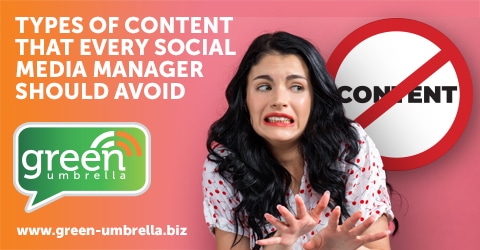Types of Content That Every Social Media Manager Should Avoid

Types of Content That Every Social Media Manager Should Avoid

Let’s be honest here, we are now living in an age where general consumers understand marketing more than ever before. They know that if they have been looking for a new cooker online that this is the reason why they are suddenly seeing adverts for that very same cooker. They no longer believe that it is just a coincidence.
I am not just talking about re-marketing and re-targeting. Many consumers are also aware that the reason we add viral videos to our Facebook pages is to get engagement so that our audience will then see our sales content.
If we know that consumers know this stuff, then it is time to move with the times and stop producing content that is not good or healthy for your business.
Below is a list of eleven types of content that you should avoid. Some of these are very obvious, but I still see these mistakes happening each day.
#1 – Negative Posts or Comments
Mistake number one is to actually engage with a client who has given you a bad review or written something negative about your business online. This may be a Facebook recommendation, a Google Review or in my case, someone went out of their way to write a whole blog!
For clarification, we find the best practice for anything said in a negative way online is to:-
- Always acknowledge the post, but do not get into a full conversation in an open thread.
- Try to limit the conversation to two comments.
- Encourage the disgruntled person to “DM” or “Email” you – and get it offline
- NEVER delete a negative comment
- Do not keep a negative review at the top of your page/account – always get someone else to write a positive review, so this is the first thing that people see.
#2 – Irrelevant Viral Content
Please do not share a piece of content on any of your social media platforms just because it is popular. ONLY share viral or funny content that is relevant to your audience. Alternatively, if you do like to show your sense of humour and it is perhaps not in line with your brand, then create a special time and place to create silly content, ie: #SillySaturday or #FunnyFriday
#3 – Political or Religious posts
Back in the day, I was always taught to avoid sex, politics and religion if I wanted an easy life. Whether that is at a party, a networking event or online, these topics are always best avoided. If you do venture into any of these worlds, then be prepared to:-
- Run the risk of offending a percentage of your audience who do not share your views (even if you are having an open discussion about the topic)
- Run the risk of people unfollowing you.
#4 – Spelling and Grammar
Mistake number four is not looking after the detail when it comes to spelling and grammar. Hopefully, there are very few mistakes in this particular article (if Jane is doing a good job with proofreading).
I remember I was once criticised for not using the correct version of writing numbers on my blog. For example, the title of the blog was “The 7 Deadly Sins of Social Media”. I must have received at least six emails or messages claiming that the title should have read “The Seven Deadly Sins of Social Media”. Any numbers less than ten should be written in full rather than using digits.
We are all different. If you are like me and your spelling, grammar and attention to detail is not your thing, then implement the following:-
- Install Grammarly on your desktop and phone (love this app!)
- Always read your blogs and email marketing content out loud and slowly.
- If you can ask someone that has got good ninja grammar skills (like Jane!), then ask them to proofread your content before you hit the publish button.
#5 – To Much Broadcasting

The purpose of social media is to build brand awareness, relationships and communities. The key is in the word “social”. I urge you to take a look at your last ten blogs, Facebook or LinkedIn posts and see how much of that content is “broadcasting” content. If you are not sure, then check to see if you are using words such as “we”, “our”, “us” or your company name in the content. If you are, then you are broadcasting – even if you think you are sharing the benefits to the customer, it is still broadcasting.
#6 – Your Content is Inconsistent with Your Brand
It is off-putting to see a familiar company posting content that is not consistent with their brand. Can you imagine Virgin Media posting something that was not on brand? It just would not happen.
A brand is not just the logo; it is also fonts, colours, the tone of voice, style, content themes, etc.
If you can’t imagine your company leader saying these things in person – don’t say it online!
#7 – Misleading Posts or Fake News
Headlines should be attention-grabbing, not misleading. Social Media giants such as Facebook, Twitter and LinkedIn are on a mission to squash fake news (as I am sure you have seen in the press), so please do not contribute to this as it no longer works. Avoid making claims that are not true in order to gain clicks.
#8 – Give Credit Where Credit Is Due
It’s ok to post other people’s content. In fact, we highly recommend doing so. But please, give credit where credit is due! Even last week, Twitter introduced the “Original Tweeter” badge that identifies the content creator. Remember, do NOT copy images from Google!
#9 – Limiting Your Types of Content
If you only produce one style of content (a blog for example), then you are naturally ringfencing your audience. People absorb information in different ways, so experiment with producing a variety of content such as podcasts, videos, whitepapers, ebooks, webinars, etc. Try each version for a minimum of six weeks to give you data so that you can analyse what type of content works best for you. As good old Einstein said, “If you keep doing the same thing over and over, then you will get the same results” (Or something like that?).
#10 – Posting Irresponsible or Insensitive Content
Irresponsible or insensitive content simply means that you are posting content at a time and date that is inappropriate. For example:-
- Think about your prescheduled content when a worldwide disaster strikes. Do you really want posts going out that say “come on our workshop next week” when a terror attack has just killed thousands of people?
- Avoid posting about celebrity deaths with the intention of newsjacking. Actually, this is ok if the person that died is relevant to your industry. For example, if Michael Stelzner of Social Media Examiner passed away, then it would make sense for Green Umbrella to post and comment about it. But gone are the days when it is ok to post about any celebrity death just to get likes and comments. It is no longer cool.
- What is your posting strategy for holidays such as Xmas, Easter, etc.? Turn off the automated posts for these specific days.
Bonus – #11 – Avoid Using Foul Language
Unless you are a high profile person such as Gary V, I personally think that bad language is not acceptable. You never know who you are offending, so it is best to avoid unless this is what you are known for. Bad language always seems ten times worse when in the written format.
Share this!


